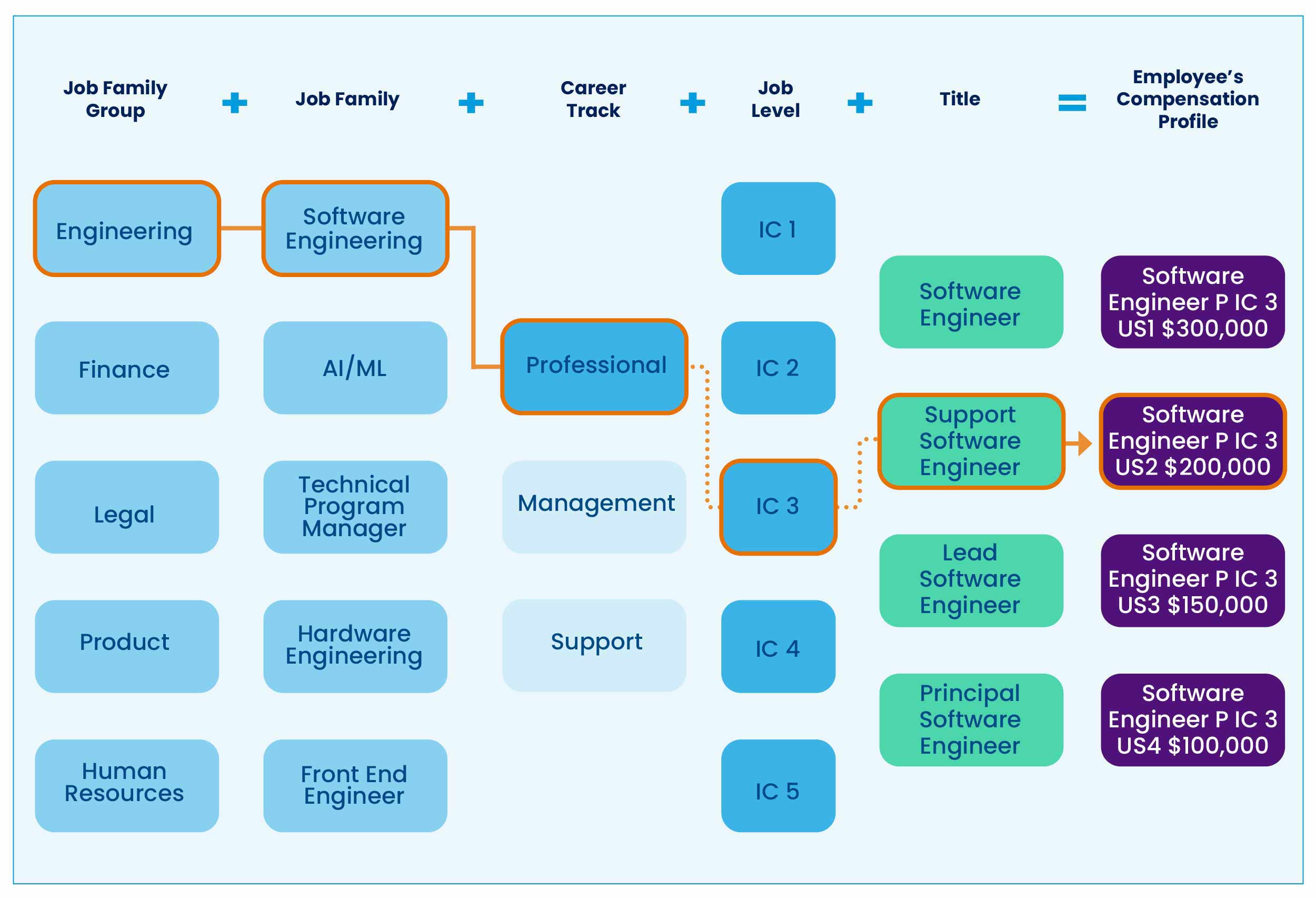- Build a sound foundation. Job architecture is a framework and way to formally compose all jobs within an organization.
- Consider your job levels. There are several methodologies for leveling jobs, such as using broad banding, a classic pay structure and market reference points. Employers may also need to build an equity structure.
- Watch for pay transparency. Remote work trends have made it challenging for employers to publish job-based salary ranges.
(Editor’s note: “Job architecture” is one of the most accessed terms on the Workspan Daily and WorldatWork platforms. At least one article on job architecture is typically among Workspan Daily’s 20 most-read pieces of content. Within WorldatWork’s member-only Engage community, the term appears in more than 1,400 message strings. To continue our coverage on this subject, this article shares some key considerations to help compensation professionals who are involved in setting up their organization’s job architecture.)
Job architecture is a framework and way to formally compose all jobs within an organization. It allows an employer to structure its job families and groups, levels, titles and career tracks (for advancement and growth) — consequently, setting the foundation for how employee pay will be assigned and allotted (see the figure below for a sample job architecture framework).

The right job architecture framework can positively impact team agility and growth, enhance the employee experience and prepare managers for positive conversations on skill sets and career advancement. Incorrect choices or neglect in this area can have opposite results.
The right job architecture framework can positively impact team agility and growth, enhance the employee experience and prepare managers for positive conversations on skill sets and career advancement.
Leveling Jobs
By examining the various components of a job architecture framework, we can get a deeper appreciation for all that is involved. Let’s start by exploring the different methodologies for leveling jobs. The ones that follow are generally more prevalent across organizations.
- Broad band levels. Broad banding is a compensation strategy used in organizations to simplify the grading of jobs and their related salary structure. An organization’s goal may well be to reduce the number of job grades. Broad banding works well in environments where managers can provide career growth within each level and employees stay at the same level for multiple years. Promotions tend to be tied to a major role change rather than doing more of the same type of work.
- Proficiency levels. This is a classic pay-structure strategy where job progression consists of multiple levels. This is most suitable for organizations that hire many early career professionals. This model works best when it is important to keep employees engaged and motivated by demonstrating career growth quickly through visible changes in job title, levels and pay. If an organization has many job levels, per this model, the distinctions between each level may be small. To establish clarity, compensation and HR professionals should define and highlight distinct differences in proficiencies, skills and responsibilities at each level.
- Market reference points. In this type of pay structure, each job is matched to market data. This establishes a reference point. Such points are useful when an organization has distinct and business-critical roles that require top talent and market-competitive compensation is a priority. The market reference point is a useful mechanism for roles that are hard to fill yet critical for the organization because this method provides very specific data. It can involve a heavy lift from an administrative perspective to ensure every role’s market data is periodically reviewed and updated. The team needs a keen understanding of the business and every role to effectively match a job to data. Incorrect matching will likely generate off-base results.
Base Salary Structure and Ranges
After designing the job architecture, you may develop base salary ranges. A salary structure is the minimum and maximum pay that the organization will provide for a role, level and location.
Occasionally, organizations may choose to have the same salary structure for an entire job level. Organizations where technology is a critical function may define a salary structure differently for technical and non-technical roles and job families. This often occurs to adequately consider prevailing market wages for technical talent.
Equity Structure and Ranges
To compete for market talent, organizations can offer equity compensation. Those that do so in addition to base salary will likely need to build an equity structure — where the amount of equity compensation is determined for different jobs within the assigned budget. Here, it can be wise to use a market benchmark based on role, level and location.
Equity compensation structures can be built in the form of targets:
- New hire: This defines equity compensation at the time of a job offer.
- Annual refresh: Equity is allocated during calendar-based refresh cycles.
Both are generally for eligible roles only. Many compensation surveys offer market data for equity, which can be leveraged to build the initial structure in the form of target equity grants.
Pay Transparency
U.S. pay transparency laws at the state and/or municipality level have forced many employers to publish base salary ranges for their jobs. This generally provides clarity to employees and applicants on how an employer compensates for each job at a given level.
To enable transparent pay information, an organization needs to ensure its job architecture foundation is laid out well. Jobs that bring higher organizational value are (or should be) paid more than lesser-value roles.
Employers should strive for equitable pay and transparency among employees at a similar level and job role. It may also increase the chance that the right quality and caliber of applicants apply to a job posting.
Pay Zone Structures
In addition to salary structures being driven by levels and job families, pay zone structures have become a prevalent practice for many organizations in the U.S. and other countries. In the U.S., this is largely driven by the differing cost of labor between states. States with a higher cost of labor (e.g., California and New York) may necessitate a higher pay zone than those with a lower cost of labor (e.g., Ohio and Florida). This means the same job/role may cost more in certain geographic areas than in others because cost of labor is a primary driver of compensation.
Recent remote work trends have made it challenging for employers to publish some salary ranges, since they may not know upon posting where the right candidate will reside (e.g., California vs. Ohio). In these cases, some organizations publish a broader range that spans multiple pay zones and determine final pay based on the candidate’s home location.
Build the Infrastructure
A robust job architecture is crucial for organizations looking to enhance employee experience, agility and growth. By choosing the right framework, clearly defining job levels and implementing transparent pay structures, organizations can foster a fair and motivating environment.
As remote work trends evolve, staying adaptable and creative in salary disclosures will be essential. Compensation professionals play a pivotal role in this process by increasing the likelihood that the organization will remain competitive and equitable from the perspective of pay.
Editor’s Note: Additional Content
For more information and resources related to this article, see the pages below, which offer quick access to all WorldatWork content on these topics:







